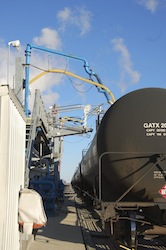The railroad industry is America is struggling to keep up with demand and according the Bob Dinneen, president and CEO of the Renewable Fuels Association (RFA), this is negatively affecting deliveries of ethanol and biofuel co-products. In a letter to Ed Hamberger, president and CEO of the Association of American Railroads (AAR), Dinneen sent a list of questions that address the “abject failure of the rail system to adequately address the needs of all of its customers.”
According to Dinneen, U.S. ethanol is the lowest price liquid transportation in the world, saving American consumers between $0.50 and $1.50 per gallon. He writes, “Over the past several we eks, however, the sheer chaos that is today’s rail system is denying consumers that price relief by driving up the transportation cost for and impacting the supply of ethanol and other commodities. Nothing has changed with regard to ethanol production costs or efficiencies. The only change has been abject failure of the rail system to adequately address the needs of all its customers. The U.S. economy is suffering as a consequence.”
eks, however, the sheer chaos that is today’s rail system is denying consumers that price relief by driving up the transportation cost for and impacting the supply of ethanol and other commodities. Nothing has changed with regard to ethanol production costs or efficiencies. The only change has been abject failure of the rail system to adequately address the needs of all its customers. The U.S. economy is suffering as a consequence.”
Dinneen says the letter spells out in clear detail the limiting impact the rail situation is having on the ethanol industry. He writes, “In response to increasing demand, the ethanol industry was producing at an average rate of 949,000 barrels per day (bpd) in December 2013. But disarray on the rail system in the first quarter of 2014 has forced ethanol producers to significantly curtail output. By the first week of March 2014, ethanol output had fallen to 869,000 bpd, as producers were forced to slow down. Onsite storage tanks were brimming full and, in many cases, the railcars and/or locomotives needed to ship ethanol were simply not available. As a result, ethanol stocks in key regions have been depleted and prices have increased. All of this is due to the turmoil on the rails—dislocated railcars and locomotives, increased terminal dwell times, slower train speeds, an insufficient number of crews, and a shortage of spare railcars and locomotives.”
The railroad industry has blamed the winter weather as the major problem but Dinneen says this is simply an excuse. “The railroads have attributed this lackluster performance and inefficiency to winter weather. But they seem to have forgotten that winter comes every year!… Indeed, a more plausible explanation for the severity of the current epidemic is the explosive growth in railcar shipments of Bakken and Canadian crude oil.”
Dinneen continues, “The surge in crude oil production from fracking has reshuffled the existing fleet of railcars and locomotives, pressured lease rates, changed normal rail traffic patterns, and generally exerted significant stress on the rail system. According to AAR, crude oil shipments have increased from 9,344 carloads in 2008 to 434,032 carloads in 2013. In addition, AAR data show rail shipments of industrial sand nearly tripled between 2008 and 2013, stating, ‘…frac sand is almost certainly the primary driver behind the increased industrial sand movements on railroads over the past few years.’ It seems absurd to suggest, as some have, that the efficiency of the rail system has been unaffected by the 4545% increase in crude oil shipments and the 170% increase in sand shipments since 2008.”
Click here to view the list of questions and the full letter.

